Kyoto and the Tang Dynasty
- Cathy@zusetsu

- Aug 5
- 19 min read
Updated: Aug 6

To A Talkative Guest (836 CE), by Tang dynasty poet Bai Juyi:
The town visitor's easy talk flows in an endless stream;
The country host's quiet thoughts ramble timidly on.
'I beg you, Sir, do not tell me about things at Chang'an;
For you entered just when my lute was tuned and lying balanced on my knees.'
Introduction
I had long read that the old capital of Japan, Heian-kyou (Kyoto, established 794 CE), 'Capital of Peace and Tranquility', was modelled on the glorious city of Chang'an, the 'City of Eternal Peace', China's capital during the years of the Tang dynasty in the 7th-10th century. But it was only when I journeyed to the current Chinese capital Beijing this summer that the doors in my mind flew open, and I began to search to try and understand what this beguiling city had been like.
Foremost in my mind was the knowledge that, like many of China's neighbours, Japan's earlier capital Nara (710-784 CE) had looked to China's contemporary capital city, Chang'an, (modern day Xi'an), for inspiration in all things, from bureaucracy, governance, education, architecture and urban planning, to cosmology, religion, fashion, and poetry.
At this time, Chang'an was possibly the most modern and exquisitely beautiful city in the world, and so it is no wonder that when Japan looked to build its first capital city, the emperor and his courtiers looked across the sea for inspiration. Certainly, the Chinese influence was still considerable when the capital moved to Heian-kyou (Kyoto) in 794.
But, how did this manifest? What was it about Chang'an that was so impressive and mesmerising?
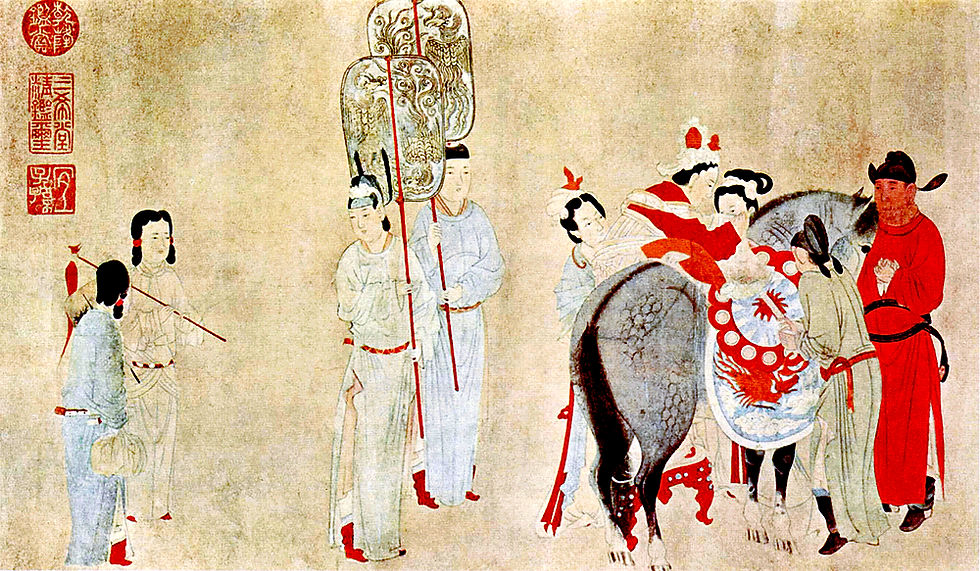
…High rose Li Palace, entering blue clouds,
And far and wide the breezes carried magical notes
Of soft song and slow dance, of string and bamboo music.
The Emperor's eyes could never gaze on her enough...
When I first visited Kyoto, I was astonished by its beauty and I was keen to try and understand how this had evolved. I went back to the early literature of Heian-kyou: the court diaries and poetry, and of course the enchanting Tale of Genji.
The first chapter of Murasaki Shikibu's great novel draws heavily on the poem by Heian-kyou favourite, Tang Dynasty poet Bai Juyi called The Song of Unending Sorrow. The poem is used as a device to convey the deep sorrow of Prince Genji's father for the death of his beloved consort, Prince Genji's mother.
The poem concerns the grieving Tang emperor Xuanzong of Chang'an for his beloved consort Yang Guifei. The clear allusion to the Tang at the opening of the Tale, roots the novel in a culture which still held influence over the Japanese court at this time.
The earlier years of the Tang dynasty - up until the middle of the 8th century, were a time of a magnificent flowering of Chinese culture. Heian Kyoto was founded on the wholesale Tang influence of the earlier capital, Nara.
Come with me as I discover more about how the glorious Tang inspired a Japanese city of beauty.
Reading Materials
When I walked the streets of China's modern capital Beijing this summer, I was flooded with questions and and keen to learn more about China's Tang Dynasty (618-907 CE), and understand a little more about how it influenced Japan.
To colour in my understanding of this fascinating period of Asian history, I have turned to Michael Wood and his wonderful Story of China.
In Edward Schafer's Golden Peaches of Samarkand, I've read an extraordinarily detailed and fascinating account of tributes carried over the high mountain passes, and brought to the emperor of the greatest city in the world located at the far end of the Silk Road. Tang dynasty Chang'an (modern day Xi'an), was the cosmopolitan marvel of its time.
I've travelled in my imagination from Kyoto's Enryakuji on Mount Hiei, over the perilous seas from Fukuoka in Japan to China's ethereal and sacred Wutai mountains, and to the Tang capital Chang'an with the Japanese Buddhist monk Ennin and his wonderful 9th century diary.
I've learned about the monk Xuanzang, and his incredible journey walking west from Chang'an across deserts and high mountain ranges to India, to discover the tree under which the Buddha gained enlightenment. His single-minded focus was to bring transcribed Buddhist texts back to the Chinese capital.
And lastly, I narrowed in on late, war-torn Tang China by reading Michael Wood's passionate account of China's most revered poet Du Fu, and learned how his poetry documents his desperate travels to lead his family to safety in such troubled times.
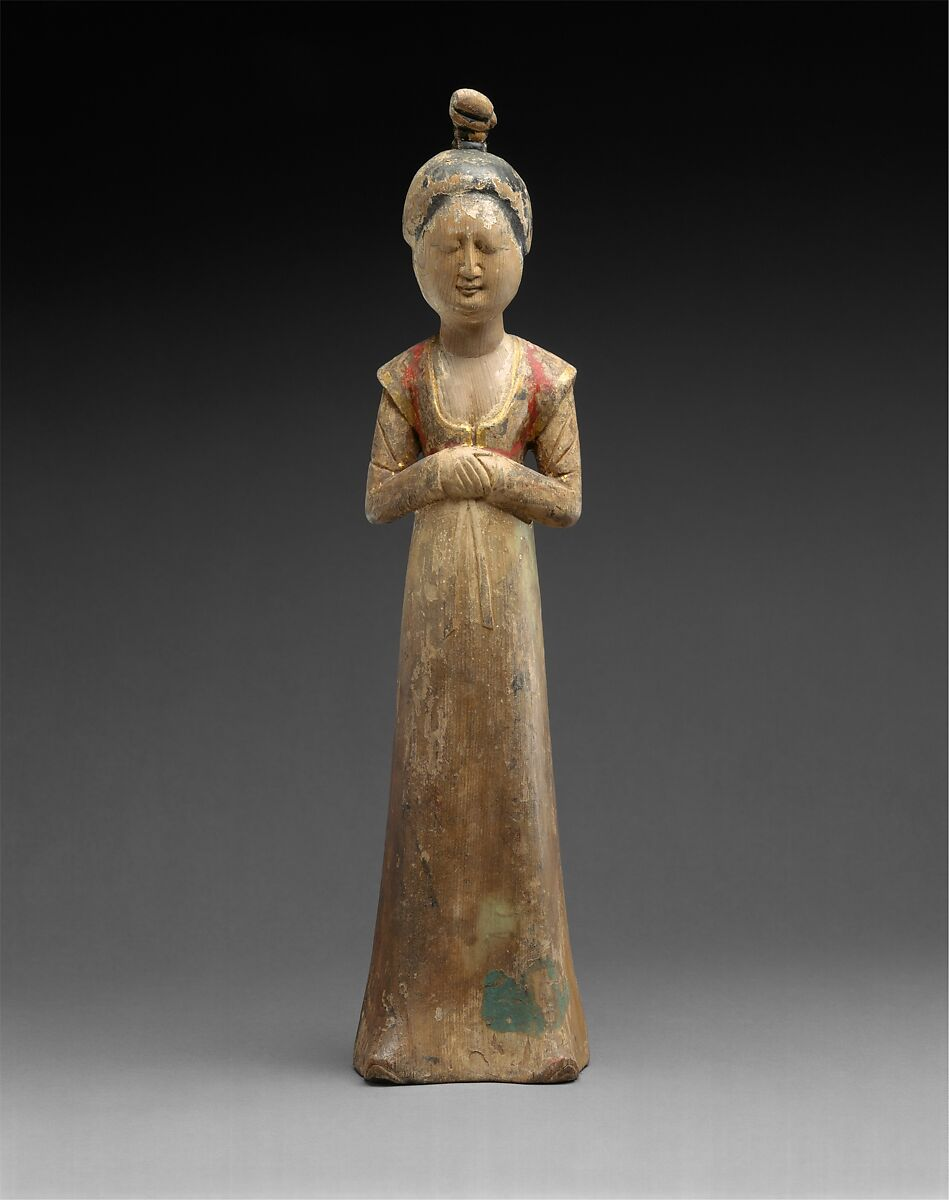
Introduction to Tang Dynasty China
The Tang dynasty is viewed as one of the great eras of the past. It lasted for almost 300 years, between 618-907 CE, and it created one of the greatest empires in Chinese history.
The Tang empire extended west along the deserts towards the Central Asian mountains. It cast tremendous influence over its neighbouring countries - Korea, Japan, and Vietnam all looked toward China as the centre of the cultural universe.
The Tang capital city, Chang'an (modern day Xi'an) was probably the greatest city in the world with a population of about one million. It was a very cosmopolitan era, with the capital located towards the eastern end of the Silk Road.
All kinds of luxuries and exotica were brought by merchants along the Silk Road from far away places. Religions such as Buddhism entered China by way of India, crossing the great mountains of Central Asia. It was a period when China was at last united, and when the economy was booming owing to this increased trade and desire for luxury goods.
Many different peoples flooded the markets with their wares, bringing with them unusual dances and fashions, particularly from Central Asia, from places such as Samarkand, and Chang'an is known for its cultural diversity. Religious diversity was welcomed too, with temples devoted to Zoroastrianism, Buddhism, Daoism, and there was also a Christian church.
The arts flourished during the early Tang, and there was a tremendous fashion for all things Central Asian. It was a fantastic time for education too.
The glory of the Tang dynasty was the first half of the 8th century, but during the middle of the 8th century - in 755 CE - a man of Sogdian and Turkik descent, An Lushan, led a rebellion down from the north and captured the capital city. This was the beginning of the end for the Tang dynasty.
Many aspects of Japan today derive from what was learned from China during the earlier Tang era. My focus in this blog is to discover how some of these aspects of the glorious Tang dynasty and their capital Chang'an influenced Heian Kyoto.
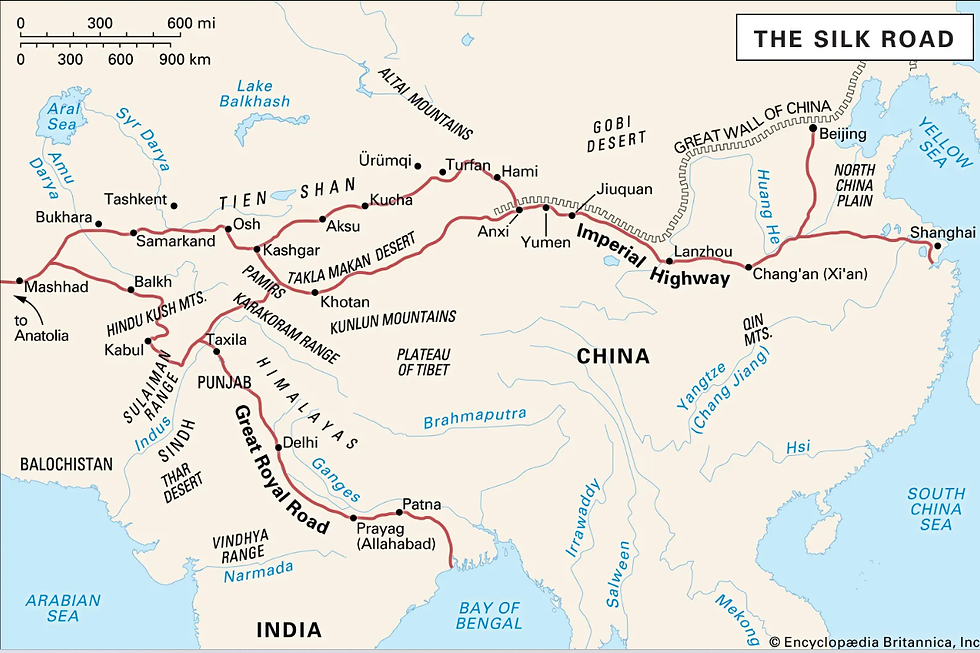
The Silk Road
The Tang empire expanded west in order to protect its interests where the long distance caravan trade routes brought luxury goods down to the capital. They pushed their empire beyond the mud walls, beacons and watchtowers of western China, out towards Central Asia and the merchant trade routes which travelled through Samarkand.
The Tang capital Chang'an embraced the people bringing exotic goods to their city. These were people from Samarkand, Persia, Kashmir, India, and Greece - through Alexander the Great's campaigns in Central Asia. Chang'an became a cosmopolitan city, the glory of the contemporary world.
It was perhaps natural for the Chang'an emperors to look west. The Tang ancestors - the Li clan - were from the north west. It is claimed they shared kinship with the Khan of the Kyrgyz (who centuries later would establish the capital at Beijing). They were skilled horse people.
There were two ways into China, overland by caravan or by the sea routes. People travelled by caravan with camels which could detect water in the desert.
In The Golden Peaches of Samarkand we read:
People settled along this corridor of caravans which led westwards into Turkestan. Here along the margins of the Gobi desert were Chinese towns, spaced at regular intervals, and equipped with caravanserais.
There was an amazing network of ports, canals, roads, sail-powered boats across lakes, and mountain passes to reach the dazzling cities of China.
China's capital, Chang'an, was a major stop on the eastern end of the Silk Road, with Japan at the far eastern end, and Rome and the Mediterranean at the far western end.
An artificial lake was built east of Chang'an, and here boats gathered from every part of the empire, loaded with goods bound for the great city.
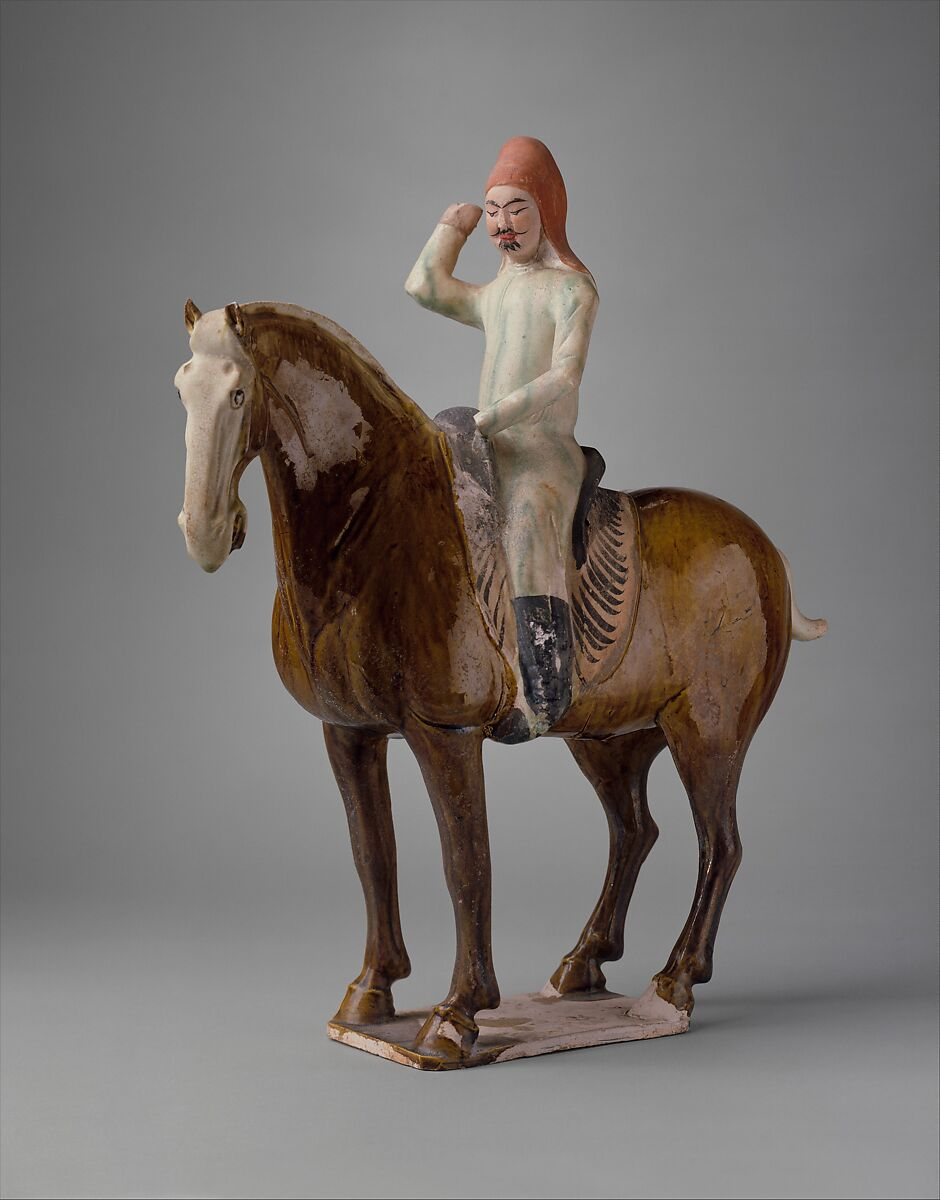
The Capital City, Chang'an
In The Story of China, Michael Wood tantalisingly describes Chang'an:
The main part of the city was divided by a grid pattern into 108 wards, with smaller winding alleys between the temples and houses. On the east side were the grand aristocratic houses...There were gardens and trees everywhere. The guidebooks to the Tang dynasty city describe scenic beauty spots adorned with peonies and peaches, lotus and apricot gardens, fruit orchards and parks that ran along the ..river and lake.
And in his book about the poet Du Fu, Wood again describes the capital wondrously:
Chang'an was then a world city like Baghdad or Constantinople, a giant five-mile rectangle filled with temples, gardens, orchards and vast wooden palaces rearing over the quarters of low-rise houses. At its heart was the imperial Daming Palace, three times the size of the later Forbidden City in Beijing.
The Ming Forbidden City in Beijing is astonishingly vast - with large distances between the sweeping golden rooves of the palaces. I am struck with awe trying to imagine the Daming Palace and the exotic beauty of fabled Chang'an!
In Chang'an there were two great markets, one on the east of the city and one on the west. One of the markets is for foreigners, merchants who bring luxury goods along the Silk Routes and trade for silks:
In The Golden Peaches of Samarkand we discover:
Chang-an had two great markets, the Eastern and the Western, each with scores of bazaars. The Eastern Market was the less crowded of the two, and quieter and richer, being situated near the mansions of the nobles and officials; the Western was nobler, more vulgar and violent (malefactors were punished there), and more exotic. Each bazaar, with its unique kind of merchandise, was surrounded by warehouses, and each was required by law to display a sign naming its specialty.
Overlooking the quieter Eastern Market were the houses of the scholars and the court musicians.
Proceeding through the Western Market, where most of the foreign merchants displayed their wares, one might see in succession the butchers' bazaar, the ironmongers' bazaar, the clothing bazaar, the bazaar of saddlers, the silk bazaar, and the bazaar of the druggists. After the middle of the eighth century, the tea merchants were particularly popular.
This is a world for the caravanserais to find kit for repair and travel: saddle gear and tools, but it's a place to uncover beautiful foreign jewellery brought from the countries beyond, and all sorts of Central Asian clothing.
Coins were developed with holes in the centre so that they could be strung together. They replaced the earlier taffeta strips, and encouraged the booming economy.
This is a merchant city with people entering from all over Asia, bringing their exotic items as tributes to the Tang emperor or as saleable goods. Some came to study - the imperial examination system enabled a rise in status so that bureaucratic power was not held solely by hereditary aristocrats. It ensured that part of the power was held by people of intellect who were prepared to work hard.
When an envoy arrived in the great city, such was the bureaucracy of the time that he required official credentials. The most important was a halved token in the shape of a fish. The countries that maintained good relations with Tang were assigned one half of these numbered fishes, and the other half was kept at the Chang'an palace. When the envoy arrived at the city at the correct allotted time for his visit, and his halved fish token matched the one kept in the city, he was afforded the rights due to him.
And if he was of sufficiently high rank to attend the great reception for tributary princes held on the day of the winter solstice, he would witness the full spectacle and might of the Tang imperial power.
Cosmopolitan Chang'an in this Tang period blossomed under the influence of the travellers bringing luxury gifts to the capital.
The fashions were exotic and incredibly creative, inspired as they were by fashions from the foreigners travelling along the Silk Road. Kazakh style capes and boots were the thing for ladies as well as men, or high hooped hairstyles adorned with tinkling jewellery or huge peonies, while the ladies draped themselves in hand-dyed batik-style prints and beautiful floaty silks.
I was fascinated to see the painting of the Tang palace ladies pictured below, discussed by Alastair Sooke in his BBC programme China's Greatest Treasure (episode 2). The palace lady on the left appears to be adjusting the translucent garment that she is wearing. The thin quality of the fabric and the pale yellow tone brings to my mind the highly talented Nishijin weaver who I was very honoured to meet in Kyoto. His passion had been to recreate silken ra, a gauze-like textile which was made in China over a thousand years ago. He told me it looked like a cicada's wing. For his tremendous effort at recovering this lost knowledge, and for recreating this exquisite fabric, he was made a National Treasure of Japan.
The lady's gauze wrap certainly looks like a cicada's wing. The fashions are enchanting, and I can't help being drawn to those loftily painted eyebrows - so reminiscent of the plucked and repainted eyebrows of the ladies of the Heian court. These Tang palace ladies drew their butterfly-like eyebrows high to indicate their status.
Even more wonderful in Alastair Sooke's programme is the visit he makes to a studio in Beijing where the clothes of the lady on the left in the painting are recreated using original techniques and consequently natural materials. We see exactly how this lady would have appeared - and she's enchanting!
It's perhaps easy to see how the exquisite many-layered gowns of the Heian court ladies came to be, as the fashion of noblewomen in the earlier Nara capital was heavily inspired by the Tang court. The Tang influence naturally lessened as the years turned, but Heian Kyoto was still fairly imbued with Chinese culture.

The Golden Peaches of Samarkand tantalisingly lists an inventory of items brought as tributes across the mountains to Chang'an.
In eighth century China, the desire for foreign clothes, foreign food, and foreign music was immense. The people of the city thrived on the novelty of the goods and people who arrived from other lands. And the descriptions are so vivid, we can imagine that we might be there in the exotic dust of the city:
...by the early part of the eighth century women were riding about the dusty streets wearing Turkish caps or even bare-headed, and dressed in men’s riding clothes and boots. Other exotic fashions of mid-Tang were leopard-skin hats worn by men, light sleeves and fined bodices in the Iranian styles, worn by women along with pleated skirts and long stoles draped around the neck, and even hair-styles and makeup of 'un-Chinese' character...
And we discover our Heian court's favourite Tang poet living his life in a very colourful way!
Enthusiasm for Turkish customs enabled some aristocrats to endure the discomfort of living in a tent, even in the midst of the city. The poet Bai Juyi erected two Turkish tents of sky-blue felt in his courtyard and entertained guests in them, proud to demonstrate how they furnished protection from the winter wind...
These exotic influences extended to all conceivable arts: fashion, architecture, food, paintings, dance, and music. During the Tang we begin to see the great development of Chinese landscape painting.
Dancers included the twirling girls from Samarkand, dressed in crimson robes with brocade sleeves, green damask pantaloons, and red deerskin boots, who twirled aloft rolling balls. The dancers were so popular with the emperor Xuanzong that his favourite consort Yang Guifei learned how to dance too.

Almost equally attractive during those exciting years were the wild beasts of strange lands, especially those sent with missions as gifts to the Chinese court: elephants, rhinos, leopards, tigers, peacocks. They loved falcons too, hawks and hounds, and of course horses.
Horses were at the very heart of Tang culture. Essentially permitted for the aristocracy, they were necessary for travel and warfare, as well as the popular Tang sport of polo. The Tang originated as the Li clan in the north west of China, and they were renowned as skilled horse riders. Horses were greatly prized as tribute and gifts, especially those from the high mountains of the west, and remote places such as the valleys of Kashmir, where it was believed that their fine horses bore dragon blood.
Delicate fruits and flowers were packed in high mountain snow, or stored in little baskets with flower stems dipped in wax, to preserve them on their long journeys to the capital.
There is another story about the lady Yang Guifei, who relished lychees so much she had them carried to her in the city from far away. In this poem by Tu Mu, he looks back to a golden age, in a way that is reminiscent of a western poet lamenting the fall of Troy:
Looking back at Chang-an, an embroidered pile appears;
A thousand gates among mountain peaks open each in turn.
A single horseman in the red dust--and the young Consort laughs,
But no one knows if it is the lychees which come.
This taste of the Tang for the imported, luxurious, and exotic, culminates in a romanticised nostalgia for the fantastic gifts brought in tribute from foreign lands in years past. Edward Schafer writes: We have to deal, then, not with the charm of genuine imports, but with the glamour of wares that existed nowhere on land or sea.

And this statement resonates with a scene in the 9th century Japanese tale Taketori Monogatari, which we might know better as The Tale of Princess Kaguya. The three aristocratic suitors of the princess are sent on perilous adventures to retrieve impossible luxuries - things that cannot exist - as the princess does not want to marry them at all.
Their journeys mirror the 9th century monk Ennin's incredibly perilous journey to bring back Buddhist scripture from late Tang China. And it mirrors the sublime journey of our 7th century monk Xuan Zang, who travelled west across deserts and high mountain passes to reach India and the original texts of Buddhist lore.
Their journeys are so amazing, and continue our exploration into Tang culture so vividly I have written a separate blog about them. You can read it here!


Chang'an, Nara, and Kyoto
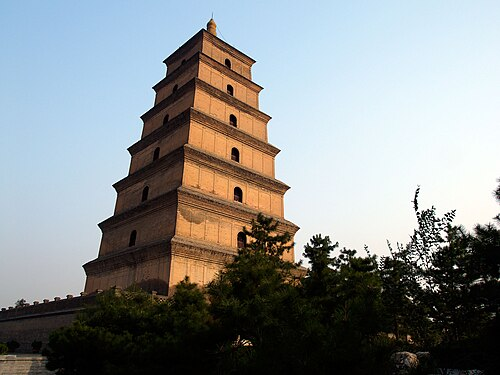
The descriptions that I have been reading of Chang'an create the most beguiling images in my imagination. I would love to travel to Xi'an to see the great Wild Goose Pagoda, which was where the Buddhist sutras and statues brought to China by Xuan Zang were once stored.
But I was delighted to read that the best place to travel in the modern world, to gain an impression of what a Tang city looked like, is Nara. Here are the great Buddhist temples, such as the Todai-ji, until recently the largest wooden structure in the world. And here, carefully stored for hundreds of years, are the Tang treasures and tribute gifted to the old capital. Kept in remarkable condition, the Shoso-in storehouse (now a fine museum) is a truly amazing collection of 8th century Tang treasures which have been carefully curated across the centuries.
Amongst the Shoso-in treasures is a beautiful rare harp from Tang China, made from light pawlonia, inlaid with birds and flowers and mother-of-pearl, with twenty-three strings attached to pins made from deer bone. Here, there is a rare lute embellished with floral inlays of mother-of-pearl, tortoise shell, and amber; and an armrest used by the Nara emperor Shōmu, decorated with gold, camphorwood, and stained ivory. The collection includes elegant writing brushes made from decorative spotted bamboo.
Michael Wood describes more of the Tang treasures that can be found at the Shoso-in:
Here one may see Tang lutes and wind instruments, lacquer work, silk and textiles, glass bowls, cups and pitchers from Persia and Alexandria, Roman glass, Persian brocade, Indian carvings, Chinese rugs, clothing and weaponry, and Buddhist scrolls from Sui and Tang China. Among the treasures are also costumes, masks and instruments used for eighth-century ceremonies that show the faces of different peoples along the Silk Road. Few artefacts as astounding as this have survived the vagaries of war and revolution in China, but here in Nara in Japan is the single most powerful symbol of Tang cultural exchanges along the Silk Road during this expansive time.
Nara was Japan's first permanent capital city, named Heijō-kyō, during the years 710-784 CE. Just as in the Meiji period, when Japan opened up its borders and underwent a rapid transformation deeply impressed by the West, during the Nara era almost every important aspect of the exquisite culture from the Tang capital Chang'an was borrowed enthusiastically. Nara was, in many ways, a scaled down copy of Chang'an. The Japanese imperial court was modelled on the template of the Chinese imperial court. The bureaucratic systems were likewise adopted - even down to the colour-coded system of outer robes which denoted rank. The language of education was Chinese, the language of poetry was Chinese, and the collected anthologies of poetry were also borrowed from the Tang.
Buddhism had crossed to Japan by way of the intrepid monks who had brought scripture and statuary across the mountain passes and deserts from India into China. Chinese dance and art and objects were highly valued, regarded as high status, as we repeatedly see when we read The Tale of Genji.
But it's interesting that those 10th century courtiers in The Tale of Genji, while being classically educated in Chinese, and composing poetry in the way of Chinese verse, nevertheless are looking back to the earlier glory of the Tang of 150 years before.
And most fascinating of all, is the way that aristocratic women were excluded from being educated in classical Chinese, which encouraged them to develop the new type of phonetic writing - hiragana - with which they recorded their nikki (diaries), poetry, and in the case of Murasaki Shikibu, her ground-breaking novel.
One of the most beautiful aspects of Japanese Heian waka poetry, the references to nature and the symbolism inferred by these references, emerged under the cultural influence of China.
Nature was used to express human emotion in the poetry - a wild goose in the sky suggested loneliness; plum blossom in the February snows suggested resilience. The Heian court was very adept at composing spontaneous poetry which created this emotional reference, as well as creating poetry which resonated with allusions to classical Chinese poetry. Heian poetry is highly textured in this way - and its foundation was Chinese landscape art as well as its literary antecedents which extend back four thousand years.
Haruo Shirane writes:
Many of the natural motifs that appear in eighth-century waka (such as the plum, peach, and mandarin orange) do not reference plants found in the wild, but trees that had been imported from China and were cultivated in the gardens of aristocrats.
So much of Heian Kyoto originated in Tang Chang'an.
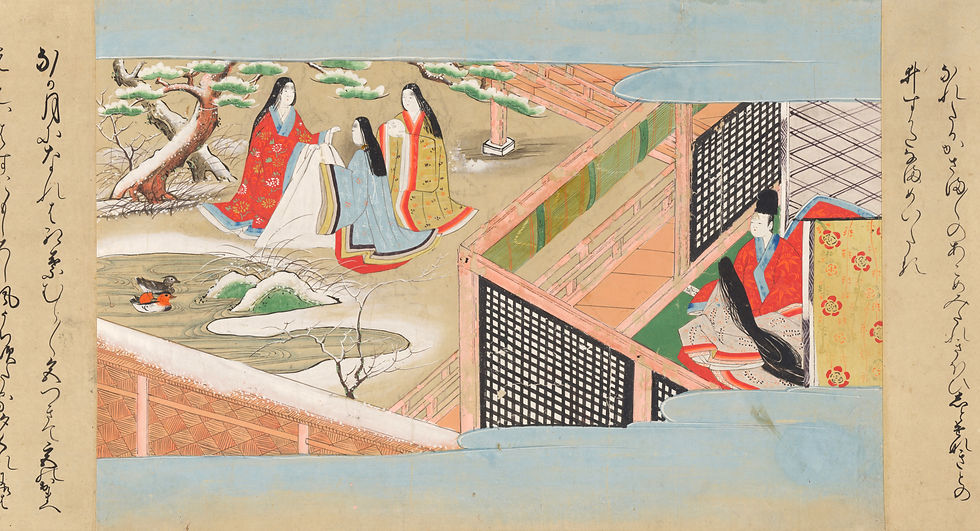
Chinese Geomancy
The Japanese emperor moved his capital city to Nagaoka for a short while, before deciding on Kyoto as his preferred place, in 794 CE. As you can see from this quote from the Heike Monogatari, a key factor in his decision was the auspiciousness of the location.
Then in Enryaku 3, the tenth month and second day (784), Emperor Kanmu moved his seat from Kasuga, in the imperial city of Nara, to Nagaoka in the province of Yamashiro. In the first month of the tenth year, he sent the grand counselor Fujiwara no Oguromaru, the consultant and left controller Ki no Kosami, the grand prelate Genkei, and others to inspect Uda in Kadono county, also in Yamashiro. The two officials reported as follows:
'The lay of the land, Your Majesty,
offers at your left the Blue Dragon,
the White Tiger at your right,
the Red Bird before you,
and behind you the Dark Warrior:
each of the four gods is in his place.
For your capital it is perfect.'
Auspiciousness was fundamental to the location of the Japanese capital, and the capital was moved to Kyoto in 794 under the instruction of Emperor Kanmu. The location of the city was chosen because bad spirits were believed to come from the north east, and Kyoto had the mountains in this direction to protect it.
Auspiciousness is just one of the concepts which were uniquely Chinese, and it is clear when reading the Heian ladies' diaries and Genji, just how much their lives and fates were governed by auspicious calendar dates and auspicious directions. (I have even discovered that the citizens of Kyoto to this day refer to a calendar of auspiciousness).
In the book Golden Peaches of Samarkand, we read:
On first arriving at the capital (Chang'an), the embassy was put up for a while at one of the hostels situated at each of the four major gates of the city, facing the cardinal directions.
These cardinal feng shui directions are replicated at Heian-kyou. The 'white tiger' originated in the snow-covered mountains in the west of China where historically tigers lived, and so the west of Kyoto is associated with the direction of the white tiger. Likewise, the east is the direction of the blue dragon, and there has long been a legend of a blue dragon living in a pool beneath Yasaka Shrine. Running south from the palace was the south gate, named after the Vermilion Bird (just as in China where is was called 'Zhuquemen'. (The dark warrior is, I believe, the eight-foot tall warrior made of clay and clothed in battle armour, who is buried on the hill above Chion-in, ready to reanimate in times of trouble).

Year designations in Japan have long been recorded according to the corresponding reign of a particular emperor: 2025 is also known in Japan as Reiwa 7, denoting the 7th year of the reign of emperor Naruhito. This system was borrowed from the Chinese system.
The Chinese zodiac is still very prevalent in Japan. The Chinese zodiac assigns an animal to each year in a repeating 12-year cycle, forecasting key events in the year ahead and the special characteristics of those born within each animal cycle.
I believe I have only just scratched the surface of how Tang China influenced Nara,
and then more subtly Kyoto, but it's fascinating, isn't it!
I like to think this poem by Du Fu could be interpreted to sum up the soft influence
of Tang China on Heian Kyoto:
The good rain knows its season,
When spring arrives, it brings life.
It follows the wind secretly into the night,
And moistens all things softly, without sound.
I hope you've enjoyed coming with me on my journey as I piece together the fascinating story of
the inspiration of the golden era of Tang Dynasty China
on the imperial Japanese courts of Heijou (Nara) and Heian-kyou (Kyoto).
Thank you for reading, and see you next time!
Cathy x
Sources
Literature
Michael Wood, The Story of China, (Simon and Schuster, 2021).
Michael Wood, In the Footsteps of Du Fu, (Simon and Schuster, 2023).
Edward H. Schafer, Golden Peaches of Samarkand: A Study of Tang Exotics, (Cambridge University Press, 1963), accessed online at archive.org
Ennin, Edwin O Reischauer (translator), Ennin's Diary: The Record of a Pilgrimage to China in Search of the Law, (Angelico Press, 2020).
Translated by Royall Tyler, The Tale of the Heike, (Penguin Classics), p.255.
Roel Sterckx, Chinese Thought, (Pelican, 2020).
Ryoichi Hayashi, (translated by Robert Ricketts), The Silk Road and the Shoso-in
Ivan Morris, The World of the Shining Prince, (Kodansha, 1964), pp.6-12.
Haruo Shirane, Traditional Japanese Literature, an Anthology, Beginnings to 1600, (Columbia University Press, 2007).
Haruo Shirane, Japan and the Culture of the Four Seasons, (Columbia University Press, 2013), pp.202-203.
Wu Ch'eng-en, Arthur Waley (translator), Monkey, (Penguin Classics, 1961).
Bai Juyi, Arthur Waley (translator), Chinese Poems, 'To a Talkative Guest' dated 836 CE, (Allen and Unwin, 1962), p.186.
Bai Juyi, Song of Unending Sorrow
Du Fu, 'Welcome Rain on a Spring Night', from chinese-poems.com.
Media
BBC Radio 4, In Our Time, Tang Era Poetry
BBC, Alastair Sooke, China's Greatest Treasures: The Art of Ancient Fashion
Xuan Zang movie (2016) on Amazon.
Yang Guifei movie.
Kyoto Visitor's Guide: Geomancy of Kyoto
Images
Court Ladies Wearing Flowered Headdresses by Zhou Fang - http://www.wenhuacn.com/meishu/minghua/04suitang/renwuhua15.jpg, Public Domain, https://commons.wikimedia.org/w/index.php?curid=9755234.
Horse and Female Rider, Tang Dynasty Collection, Met Museum.
Todai-ji by Carnicero, Tripadvisor
By Qian Xuan, Yang Guifei Mounting a Horse, https://commons.wikimedia.org/w/index.php?curid=149197
Silk Trade Route map from Britannica
Met Museum: Illustrated handscroll of The Tale of Genji by Ryuujo (Tatsujo), 1594.
Tang Dynasty Clothing, thechinajourney.com
Wild Goose Pagoda, Wikipedia
Princess Kaguya, Ghibli Studios.




Comments